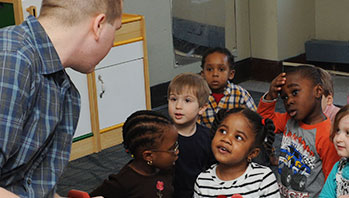- chart paper
- marker
- nighttime
- quiet
- sound
MA Standards:
Speaking and Listening/SL.PK.MA.1a: Observe and use appropriate ways of interacting in a group (e.g., taking turns in talking, listening to peers, waiting to speak until another person is finished talking, asking questions and waiting for an answer, gaining the floor in appropriate ways).
MA Draft STE Standards:
Physical Sciences/Matter and Its Interactions/PS4.B: Apply their understanding in their play of how to change volume and pitch of some sounds.
Head Start Outcomes:
Approaches to Learning/Initiative and Curiosity: Demonstrates flexibility, imagination, and inventiveness in approaching tasks and activities.
Language Development/Receptive Language: Attends to language during conversations, songs, stories, or other learning experiences.
Social Emotional Development/Self-Regulation: Recognizes and labels emotions.
PreK Learning Guidelines:
English Language Arts/Language 1 Observe and use appropriate ways of interacting in a group (taking turns in talking; listening to peers; waiting until someone is finished; asking questions and waiting for an answer; gaining the floor in appropriate ways).
Health Education 16 Recognize and describe or represent emotions such as happiness, surprise, anger, fear, sadness.
Talk Together: Nighttime Sounds

© Commonwealth of Massachusetts, Department of Early Education and Care (Jennifer Waddell photographer). All rights reserved.
STEM Key Concepts: Sounds have a source; An action has to happen to make a sound; Different objects make different sounds; Sounds vary in three ways: volume, pitch, and timbre
ELA Focus Skills: Speaking and Listening, Vocabulary
Prepare children for the reading by discussing nighttime sounds.
Turn off the lights in the room. Tell children to pretend it is nighttime and they are about to go to bed. In a quiet voice, say,
- Imagine it is nighttime and you are snuggled in your bed. Listen quietly. What sounds do you imagine hearing?
- List children’s answers on a “Nighttime Sounds” chart. Discuss the sounds they are “hearing” and where they think the sounds might come from.
- Ask children how the nighttime sounds make them feel when they hear them.
Social Emotional Tip: Ask children to talk more about nighttime and how it can be a scary time of day, but also interesting and mysterious. Have children imagine that they were walking outside in the country at night with their mom or dad. Ask questions such as, How would they feel? How does not being able to see what is making the sounds make them feel?
